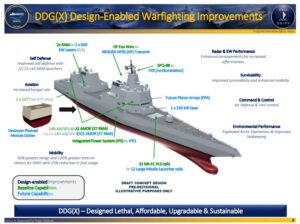The House Armed Services seapower and projection forces subcommittee’s markup of their portion of the fiscal year 2024 defense authorization bill directs reports on several aspects of the Navy’s next-generation destroyer‘s engineering plant and motor options as well as using 3D printing in the design.
Three amendments within a set of en bloc amendments approved by the subcommittee particularly focused on the next Navy destroyer to succeed the current Arleigh Burke
-class, the DDG(X). DDG(X) aims to have a new larger hull to add margin to eventually add new sensors and weapon systems like directed energy weapons and hypersonic missiles.

The panel approved a provision from Rep. Jack Bergman (R-Mich.) that directs a report detailing how the Navy can incorporate two new motor technologies, rather than focusing on just one that risks a sole source supplier situation a decade before ship construction even starts.
While the committee said it expects the Navy to conduct a “robust land-based test program for the DDG(X) engineering plant” during the detailed design period that falls before construction starting, it disapproved a May Request For Proposals on propulsion motors that require only one motor technology prototype be built and tested at the test site.
“The committee believes this will result in the premature class selection of one motor technology and one motor company, effectively creating a sole source supplier situation nearly 10 years prior to the lead ship construction start date. Moreover, this plan does not provide the Navy with a motor technology back up should the currently specified permanent magnet motor technology fail, as it did on the Zumwalt destroyer program.”
The panel argued the Navy previously invested over $300 million in the permanent magnet and high temperature superconductor motor technologies.
Therefore, “to establish real program risk mitigation, the committee believes the Navy should build and test both motors in full scale at the land-based test site.”
The subcommittee said building and testing both will mitigate program risk if one of the two fails “and in the best-case scenario a competition between two fully tested motors prior to a serial build decision providing the government the best total cost value over the expected 50+ year DDG(X) program life.”
In this vein, the committee would direct the Secretary of the Navy to give the House Armed Services Committee a report by Jan. 1, 2024 on a plan to incorporate the permanent magnet and high temperature superconductor motors into the DDG(X) test program to reduce risk and provide competition before moving on to the serial build decision.

Rep. Jarden Golden (D-Maine) also put forward two amendments incorporated in the en bloc set related to DDG(X) design.
One amendment notes that the committee “believes that additive manufacturing has the potential to provide the Navy’s surface and subsurface ships with significantly enhanced ability to sustain operations while deployed, particularly in geographically dispersed areas such as the Indo-Pacific region.”
The committee also reiterated the DDG(X) is designed to have more power generation to ultimately field advanced sensors and directed energy systems, so it will have “sufficient growth margin to incorporate emerging technologies and capabilities” like 3D printing, also called additive manufacturing.
Therefore the amendment said the committee pushed for incorporating additive manufacturing capability into the DDG(X) design to help ensure the service can maximally use the technology in the future and minimize design process risk.
The amendment directs the Navy Secretary to submit a report to the full committee by Dec. 31, 2023 on incorporating an additive manufacturing capability into the DDG(X) design. The report is directed to at least address whether the Navy plans to incorporate additive manufacturing capability into the DDG(X) design, whether the Navy plans to use metal and/or plastic/composite additive manufacturing capabilities into DDG(X) and a description of any steps the service has taken to incorporate such capability into the ship’s design planning.
Golden’s second DDG(X) amendment pushes the Secretary of the Navy to brief the full committee by December 2023 on metrics used in assessing the design tool for the DDG(X) as the Navy moves into digital engineering for shipbuilding programs.
The Navy is still considering what common design tool to use for DDG(X), which the amendment said is “an important milestone decision in ship construction.”
The committee, therefore, directs the Navy Secretary to brief the House Armed Services Committee on the metrics to be used in assessing the design tool for the DDG(X) program by December 2023.